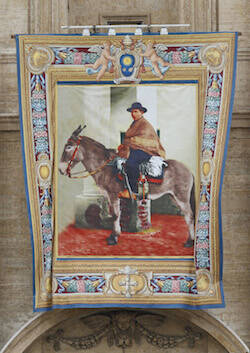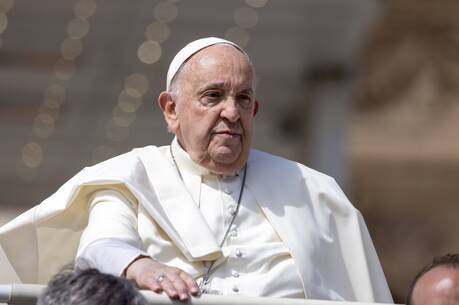Pope Francis today canonized seven new saints—two from Latin America and five from Europe—including Argentina’s first saint, the gaucho (cowboy) priest known as the Cura Brochero, who rode far and wide on a donkey to bring the Good News of Jesus to his scattered flock.
The Argentine pope did so in a solemn but also festive ceremony in St. Peter’s Square on Sunday, in what was the last canonization ceremony during the Jubilee Year of Mercy. More than 80,000 pilgrims from Argentina, France, Italy, Mexico and Spain attended the ceremony, waving their national flags and cheering when the pope declared their respective country men and women saints.
“The seven witnesses” to Jesus who were canonized today were first and foremost people who prayed, Francis stated in a short homily in which he underlined the fundamental importance of prayer in the life of every Christian, but never named any of them.
He told the vast crowd that it was “thanks to prayer” that these seven “had a generous and steadfast heart. They prayed mightily; they fought and they were victorious.”
Recalling that Jesus in the Gospel told us “Pray always, without ever losing heart,” Francis said, “This is the Christian way of life: remaining steadfast in prayer, to remain steadfast in faith and testimony.” The seven new saints did just that, “they fought the good fight of faith and love by their prayers.”
Francis explained that “commitment to prayer demands that we support one another,” and said “weariness is inevitable. Sometimes we simply cannot go on, yet, with the support of our brothers and sisters, our prayer can persevere until the Lord completes his work.”
Hundreds of people traveled from his native Argentina for this occasion, including the country’s president, Mauricio Macri, and all the bishops. For Francis, this was a very special moment as he has long considered the Cura Brochero (his full name is Father Giuseppe Gabriele del Rosario Brochero) as a model priest with “the smell of the sheep” and “a missionary zeal.” Born in Cordoba on March 16, 1840, he was ordained priest in 1869 and three years later became pastor of a parish that extended 2,694 square miles with 10,000 inhabitants who lived in distant places without roads or schools. He dedicated his life to making the Gospel known to these people, the poorest of the poor. He helped educate and promote their development in many ways, by founding villages, organizing the building of 125 miles of roads as well as schools and churches, and bringing post offices and telegraph to this area. He organized retreats for them too. He traveled far and wide on his faithful donkey called “Malacara” (“bad face”) to evangelize his people, and died on January 26, 1914, from leprosy—which he contracted from embracing a leper who had been abandoned by everyone else. He has long been venerated as a saint in his homeland; now the Argentine pope has officially declared this and offers him as a model for the whole church, and especially for priests.
The portraits of the Cura Brochero and of the other six saints hung from the façade of St. Peter’s Basilica during the ceremony. But it was the one of Argentina’s first saint that attracted the most attention because it showed him on his donkey. Sources involved in planning the ceremony said Pope Francis had insisted that the gaucho priest be portrayed with his faithful donkey, to give a more true-to-life picture of this great missionary priest. No one I spoke to in Rome could recall a donkey, or any other animal, been given such visibility at a canonization ceremony
During the two-hour long ceremony, enriched by music and hymns, Francis canonized a second Latin American, José Sanchez del Rio, a 15-year-old Mexican boy who died a martyr in 1928 during the persecution in that country. At the end of Mass, the many Mexicans present in the square sang the “Guadalupana,” the famous hymn to Our Lady of Guadalupe, with great gusto.
The five new saints from Europe that Francis canonized included the martyr Salamone Leclercq, a member of the Christian Brothers who was killed in 1792 during the French Revolution. The others were a Spanish bishop, Manuel González Garcia (1877-1940), founder of the Congregation of the Eucharistic Missionaries of Nazareth, the Disciples of St. John and the Children; two Italian priests Ludovico Pavoni (1784-1849) and Alfonso Maria Fusco (1839-1910); and a French nun, Elisabeth of the Holy Trinity (1880-1906).
After the Mass, the ever-smiling pope greeted individually the many cardinals and bishops present at the ceremony, embracing those from his homeland, which he has yet to revisit. He also shook hands and blessed countless priests before getting into the open popemobile and driving among the vast crowd in St Peter’s Square on this warm October Sunday, sparking excitement and joy.








